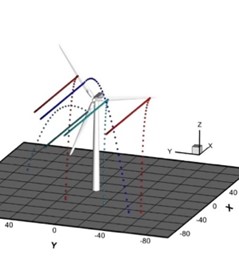Great Lakes Wind Energy Challenges
Mailing Address
Cleveland State University, Washkewicz College of Engineering
2121 Euclid Ave., WH 305
Cleveland, Ohio 44115-2214
Campus Location
Washkewicz Hall Room 305
2300 Chester Avenue
Phone: 216-687-2555
Fax: 216-687-9280
engineering@csuohio.edu
Website Issues Only
engineering@csuohio.edu
Bat tracking near wind turbines using probabilistic 3D ballistics model
Background and significance.
With the expansion of wind power plants, bat fatalities due to collisions with turbine blades are a growing concern [1]. A large number of bat fatalities near wind turbines in North America include the eastern red bat (Lasiurus borealis), the hoary bat (Lasiurus cinereus) and the silver-haired bat (Lasionycteris noctivagans) [2]. To evaluate the environmental impacts of wind energy projects, the risk of fatality when a bat enters the rotor-swept region and the fate of carcasses after collision with wind turbine blades is necessary. This project focuses on building a probabilistic-based 3-D ballistics model, which predicts the trajectory of falling bat carcasses after strike by turbine blades based on ballistics theory and bat aerodynamics. The model uses field measurements as input, and accounts for parameters of wind turbine size, blade rotation speed and pitch, and rotor orientation. It also accounts for bat carcass lift and drag characteristics and the effect of wind drift (Fig. 4). Built upon previous work [3,4], this model will be validated against video surveillance of bat strikes and measurements of fall trajectories and pre-strike flight velocities. Once validated, the 3-D ballistics model can be tailored and applied to track other avian such as birds.

Figure 4: Bat ballistics model to predict and guide carcass search [5]
REU student involvement.
REU students will learn about the environmental impacts of the wind energy development, in particular wildlife including bats and birds. They will analyze data of bats' activities near turbines recorded by X-band doppler radar and infrared video cameras, run the 3D bat balllistics model under variety of conditions and compare results with the measurements.
References
1. W. P. Kuvlesky Jr, L. A. Brennan, M. L. Morrison, K. K. Boydston, B. M. Ballard, and F. C. Bryant, "Wind energy development and wildlife conservation: challenges and opportunities," The Journal of Wildlife Management, vol. 71, no. 8, pp. 2487–2498, 2007.
2. T. H. Kunz, E. B. Arnett, W. P. Erickson, A. R. Hoar, G. D. Johnson, R. P. Larkin, M. D. Strickland, R. W. Thresher, and M. D. Tuttle, "Ecological impacts of wind energy development on bats: questions, research needs, and hypotheses," Frontiers in Ecology and the Environment, vol. 5, no. 6, pp. 315–324, 2007.
3. S. Prakash and C. D. Markfort, "Experimental investigation of aerodynamic characteristics of bat carcasses after collision with a wind turbine," Wind Energy Science, vol. 5, no. 2, pp. 745–758, 2020.
4. ——, "Development and testing of a three-dimensional ballistics model for bat strikes on wind turbines," Wind Energy, 2021.
5. J. Martin, M. Politano, S. Prakash, P. Carrica, and C. Markfort, "Optimizing bat carcass search areas using a cfd-lagrangian modeling approach," Tech. Rep., 2017.
Mailing Address
Cleveland State University, Washkewicz College of Engineering
2121 Euclid Ave., WH 305
Cleveland, Ohio 44115-2214
Campus Location
Washkewicz Hall Room 305
2300 Chester Avenue
Phone: 216-687-2555
Fax: 216-687-9280
engineering@csuohio.edu
Website Issues Only
engineering@csuohio.edu